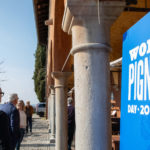World Pignolo Day, A wonderful experience to discover a multifaceted grape.

There is a distinct possibility that pignolo would have met the same sad fate as innumerable other Italian native varieties, if it had not been saved from extinction in the early 1970s thanks to cuttings taken from vines on the hill of Rosazzo, in the province of Udine. (The complete story of the rediscovery can be found in Ben Little’s book, cited below) Official recognition of the variety by the Regione di Friuli Venezia Giulia in 1978 opened the way to further planting, but it was not until 1995 that Pignolo was included in the disciplinare of the Colli Orientali del Friuli. The wine caused a great stir in critical circles of the period and there was a feeling in the air that Pignolo would become the flagship red which was missing from the region that had built its reputation on white wines. However, while its status as a heritage wine is assured, the critical mass necessary for Pignolo to make a significant commercial impact has never been achieved. Today, the majority of the 60 or so producers who make Pignolo grow less than one hectare of the variety. It is this rarity which inspired the title of Ben Little’s impeccably researched, 400-page Pignolo; Cultivating the Invisible. The book, published in 2021, has given the wine international exposure and the author’s efforts in support of Pignolo have been instrumental in the creation of the newly founded Associazione del Pignolo del Friuli Venezia Giulia, which promises a much less invisible future for the wine.

Pignolo is a late ripening variety with low yields, small bunches and small berries. The wines are high in tannin and acidity and potentially in alcohol, (especially if grapes are picked late and/or dried) with a distinctive aromatic signature of dark berry fruit with an earthiness in the background that comes from the wine’s phenolic character. Most of the wine comes from the hills of Pignolo’s native Colli Orientali, however there are also small but significant plantings in Collio, Friuli Isonzo, Friuli Aquileia and Friuli Grave.
A minimum three years ageing is obligatory to qualify for the DOP Friuli Colli Orientali (four years for the Riserva and wines from the Rosazzo sub-zone). Pignolo has a prodigious capacity for evolution, and I have the sensation that many wines only begin to peak at eight to ten years (which might mean ten years in barrel). Clearly, with this profile, Pignolo is not an immediate wine, it asks to be engaged with, but it is one of those which can set your pulse racing, as only great wines can.

Tasting notes
I had the rare priviledge of tasting 51 wines in vintages from 2019 to 2006 . I write ‘rare’, but ‘unique would be more appropriate, because assembling 51 wines in a single tasting entails a search for the almost invisible. To the best of my knowledge such a large scale tasting has never been held before.
Here, in alphabetical order, are the wines that impressed me most in the tasting. (1)
Borgo San Daniele, Arbis Ros 2018
Complex nose of herbs and wild berries, tight tannins but lovely fluid progression on the palate and intense fruit finish. Refined.
Bressan 2010
Mature complex nose of great refinement, close weave texture on the palate, dry firm sappy finish. Masterful.
Gigante 2006
Wild berrries and violets on the nose, dense and deep on the palate with velvet tannins and pristine aromatic finish. Positive evolution.
Moschioni 2013
Inky, saturated colour, ripe raisiny fruit, powerful fleshy palate, long grapey finish. Oversize but it works.
Mulino delle Tolle 2019
Dark blossom and blackberry nose, fresh juicy palate with well-integrated oak and long precise finish. Direct, appetising.
Petrucco, Ronco di Paolo 2018
Attractive, bright ruby shade, inky phenolic nose, lots of energy in mid-palate and glossy finish. Young, great potential.
Radikon 2010
Earthy, iron filings nose, concentrated power on the palate, bone dry finish of great tangy intensity. Huge personality.
Ronco di Cialla 2016
Delicate, complex nose with billberry and wild herbs, subtle but deep on the palate, great length and supplesse. Pure elegance.
Specogna 2016
Mix of fruit and undergrowth on the nose, intense vibrant palate with ripe tannins and firm underlying structure. Exemplary.
Stroppolatini 2015
Earthy, slightly up-lifted nose with enticing hints of spice, broad and dry on the palate, long savoury finish. Mature.
Vie D’Alt 2017
Understated but complex, natural ferment nose, great texture on the palate and a long grippy finish with notes of liquorice and blacberry. “Terroir wine”.
Le Vigne di Zamò 2009
Very attractive floral nuances on the nose, tight tannic palate with a bright underlying freshness and a retun of dark berries in the finish. Great vitality.
Some reflections on the tasting.
- I detected a precision in the winemaking in many of the samples which I haven’t always found tasting Pignolo on other occasions.
- I was positively surprised by the fresh immediacy of many of the younger wines.
- Having said that, I think there could be a danger of over-simplifying a complex, challenging variety.
- Some of the wines that impressed me most were dense and chewey, others had fine weave textures. What tips the balance is not so much the amount of extract as the quality of the tannins.
- The distinctive dark fruit character is a thread that runs through the vintages from the youngest to the most mature.
- Very evident new oak influences can distract from that fruit.
(1) Walk around tasting with labels in view, open to the public.